
Click To Continue transforms a simple idea into a layered test of perception, rhythm, and patience. What begins as a straightforward clicking challenge evolves into a multi-phase experience that pushes reflexes, timing, and puzzle-solving. Each level presents a new interface or mechanic, keeping you uncertain about what’s next. Beneath its simplicity lies a sequence of logic-based mini-games hidden behind deceptive buttons and messages.
The main premise of Click To Continue is to find the correct interaction method to advance. Sometimes it’s clicking, but other times you must drag, wait, or identify hidden patterns. Each stage challenges your expectations, forcing you to rethink what a button means.
The game constantly breaks its own rules, training you to think laterally. Failure is part of learning—each mistake reveals a hint about what to try next.
Click To Continue uses escalating complexity to keep engagement high. Early stages are short, but later ones add movement, sound signals, or fake clues to confuse you. The trick is to read the entire screen and look for behavioral cues rather than rushing to click.
Patience becomes your strongest skill. As you adapt, the satisfaction of identifying each trick increases, transforming confusion into insight.
Click To Continue rewards observation more than reflex speed. Watch patterns, listen for sound cues, and notice changes in interface behavior. Every element on screen can be a clue—cursor color, animation timing, or even text fading.
Because rules constantly shift, every win feels earned through awareness and curiosity. The process of discovery becomes the reward itself.
Click To Continue transforms a simple action into a journey of perception and thought. It challenges how you approach interaction, forcing adaptability and focus. Each stage reminds you that progression isn’t about speed—it’s about understanding the logic behind every move you make.